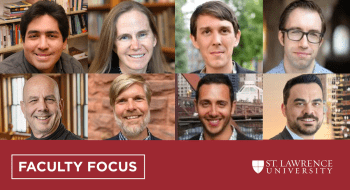
Discovering a Winning Combination as a Data Science Researcher
Saints student-athlete Hope Donoghue ’24 has always been intrigued by sports data. This summer, she combined her academic and athletic passions as a data science researcher.
During an eight-week collaborative research project with Associate Professor of Math, Computer Science, and Statistics Ivan Ramler, Hope investigated Liberty League soccer data thanks to funding from the Clare Booth Luce Undergraduate Research Scholar Program. The program provides female students majoring in the physical sciences with on-campus housing and a stipend to travel with their faculty mentor to professional conferences to present their findings.
Hope shared what it was like to dig into data as a new researcher and collaborate with her faculty mentor.
Note: Responses have been edited for length.
Hope Donoghue ’24
Major: Data science major and mathematics minor
Hometown: River Forest, Illinois
Project Title: “What Characterizes a Winning Combination? Network Analysis Using Liberty League Soccer Data”
How would you describe your research to someone who doesn’t know anything about the topic?
I explored network analysis and investigated through statistical models what connections or aspects of teammate interactions lead to higher winning percentages for Liberty League Soccer teams.
What about this topic sparked your curiosity?
At SLU, I am a member of the women’s soccer team. I took Statistics 234 with Dr. Ivan Ramler in the spring of 2022 and when he mentioned this project and how it was a continuation of the class, I was very eager and excited to join him. I have played sports my whole life and have always been intrigued by sports data and learning about player interactions and how theyaffect outcomes and performances.
Was there a moment when you felt particularly challenged during your research process? How did you overcome it?
Getting the dataset to be in the network analysis structure was challenging. In order for the code to run in R, a programming language used for statistical computing and analysis, the dataset had to be structured in a way where the nodes and edges were the first two columns within the dataset. Through a lot of trial and error and help from Dr. Ramler, I finally got it to work.
What about your research are you the most proud of?
How much I was able to accomplish in the eight weeks. I started with no prior knowledge of network analysis and now I know how to build statistical models for network objects and web scrape the internet to create datasets.
What's the most rewarding aspect of working closely with a faculty member?
I loved being able to work independently but also collaboratively with Dr. Ramler. He helped me brainstorm ideas and also let me work through the issues on my own to build up my confidence. He created an environment where I felt safe to experiment without any consequences.
Finish this sentence: “Through my research, I hope to show others that…”
Network analysis can be a helpful tool for soccer teams to use to maximize their winning performance. I found that a team has a higher winning percentage if their connectedness score (transitivity in network analysis terms) is lower. In other words, a team is more successful in the Liberty League if they have one main goal scorer and assister instead of several.



